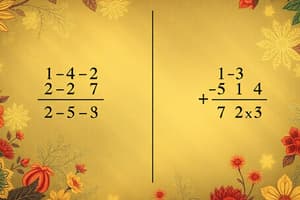Podcast
Questions and Answers
What is the process known as when multiplying fractions with like denominators?
What is the process known as when multiplying fractions with like denominators?
- Multiplying equivalent fractions (correct)
- Finding common denominators
- Reducing unlike fractions
- Simplifying complex fractions
What should you do if the fractions are not in their simplest form before multiplying them?
What should you do if the fractions are not in their simplest form before multiplying them?
- Proceed with the multiplication directly
- Change the denominators to be like
- Find the common denominator first
- Simplify the fractions first (correct)
In the process of multiplying fractions with like denominators, what should be done after multiplying the numerators?
In the process of multiplying fractions with like denominators, what should be done after multiplying the numerators?
- Divide the denominators
- Multiply the denominators
- Add the denominators
- Reduce the result to simplest form (correct)
What do you need to do if two fractions have different denominators before multiplying them?
What do you need to do if two fractions have different denominators before multiplying them?
What is the benefit of multiplying fractions with like denominators in terms of steps needed?
What is the benefit of multiplying fractions with like denominators in terms of steps needed?
Study Notes
Multiplying Fractions with Like Denominators
Multiplying fractions is typically done by finding the common denominator of both fractions and then dividing each numerator by the common denominator. However, when multiplying fractions with like denominators (where both fractions have the same denominator), you can simply multiply their numerators directly without needing to find a common denominator. This process is known as multiplying equivalent fractions.
To perform this operation, follow these steps:
-
Identify the denominators: Look for any common factors that could be used to simplify the fractions if necessary. For example, if both fractions are already reduced to their lowest terms (also known as simplified form), then you will not need to do anything additional before proceeding to step 2. If the fractions are not in their simplest form, reduce them now and move on to step 2.
- If the fractions have different denominators, you will need to find their common denominator before proceeding to step 2.
-
Multiply the numerators: Multiply the numerator of one fraction by the numerator of the second fraction. For example, if your two fractions are 1/2 and 3/4, respectively, you would first multiply their numerators: 1 * 3 = 3.
-
Reduce to simplest form: If possible, reduce the resulting product from step 2 to its lowest terms (simplified form) by dividing both the numerator and denominator equally by any common factors (other than 1). In our example, since the result is already reduced to its lowest term, we do not need to reduce it further.
The result is the product of the two given fractions: 3/2.
Example
Let's demonstrate this process with an example involving multiplying fractions with like denominators:
- Fraction 1: 1/2
- Fraction 2: 1/2
Step 1: Identify the denominators Since both fractions have the same denominator (2), we can move on to step 2.
Step 2: Multiply the numerators 1 * 1 = 1
Step 3: Reduce to simplest form Since our result is already in its lowest term (simplified form), we do not need to reduce it further.
The product of the two fractions is: 1/2 (which is already the simplified form)
Studying That Suits You
Use AI to generate personalized quizzes and flashcards to suit your learning preferences.
Description
Learn how to multiply fractions with like denominators by simply multiplying their numerators directly. Understand the steps involved in this process, including identifying the denominators, multiplying the numerators, and reducing the result to its simplest form.




